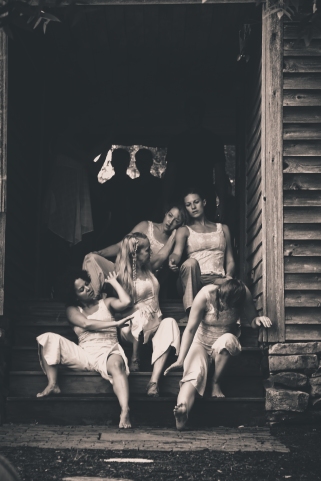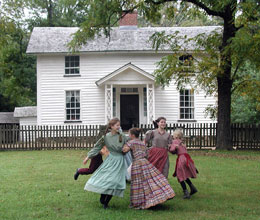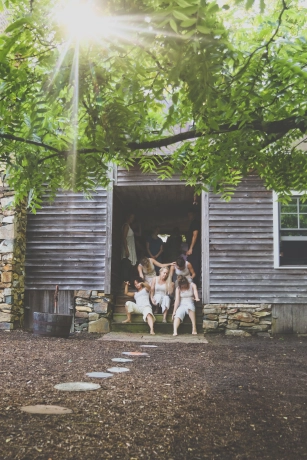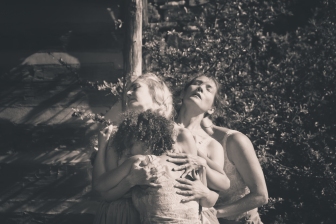Tags
Andrew Anagnost, dance, Duke Homestead, Durham, Jaki Shelton Green, Local Dance, Modern dance, Murmurations Dance, Nicole Dagesse, Site-specific, Yan westerlund
Murmurations Dance Artistic Director Nicole Dagesse believes that everyone has a story connected to birth – we were all born, after all. Dagesse’s site-specific work, “Birthing Bodies” features a group of five women – all mothers – engaging with their own physical memories of giving birth, their emotional experiences as caregivers and their family lineages of motherhood. Simultaneously, these same women engage with stories of site – both those of Duke Homestead and those within their own bodies – , support one another physically and emotionally, and respond to often-changing choreographic cues. Sound complicated? Welcome to the life of a mother.

Photo credit: Allie Mullin
Dagesse explained that “Birthing Bodies” grew as she negotiated pathways toward a balanced life as both a mother and an artist. Finding a community of women who were dancers and mothers, Dagesse said, was central to her own personal journey. The group she built includes performers Zoia Cisneros, Elizabeth Motyka, Danielle Brestel and Rebecca Drake.
“My casts tend to be a mix of people who consider themselves dancers and those who don’t,” Dagesse said. “In site work, contact improvisation, martial arts… any type of energetic work is really useful. There has to be a lack of care about getting dirty or about insects…and there must be a strong desire to explore and push boundaries.”
In a historic site like Duke Homestead, there must also be a consciousness of and respect for preserving the integrity of the space – a factor that can present challenges.
“There are specific rules that you may not anticipate in advance,” Dagesse explained, “like not hanging on a certain tree. You have to work to find a conversation with place that feels safe to the people maintaining it, but to not feel stifled as an artist because of the rules.”
Dagesse noted that the staff at Duke Homestead – Site Manager Jessica Shillingsford, specifically – has greatly facilitated her artistic freedom by offering support and aiding in problem-solving.
Though this is the first time Duke Homestead has featured an artistic performance, the path the audience takes while viewing will be similar to the historic tours offered on-site. Shillingsford explained that this particular project is special because it zooms in on the women’s stories associated with Duke Homestead.
“Nicole’s concept of artistic engagement with local places and North Carolina traditions is exciting!” Shillingsford said. “It’s our staff’s job to interpret history with words and educational activities, and I was really interested to see how [Murmurations Dance] would interpret the past via movement.”

Duke Homestead
Shillingsford explained that Dagesse’s proposal sparked her interest in the unknown aspects of Duke Homestead’s history as a birth site for three Duke children.
“We have new research and new perspectives to share with our visitors, and we will use some of our proven methods to bring that information to life,” Shillingsford said. “ We not only want people to think, we want them to touch, see, smell, laugh, ponder, relate, and connect emotionally [to the site].”
In performance, dancers engage with multiple structures at the Homestead – from the trees, to the fields, to the home itself. Dancer Zoia Cisneros spoke a bit about her experience in the piece:
“The tree stump to me is significant,” Cisneros said. “It acknowledges the generations and the support between the circle of women dancing… A lot of this piece for me is about grounding, about centering. It is almost like I am calling to the mothers, to the women in my life, when I am dancing…The images of trees turn into a metaphor for the lineage of mothers in the past and future.”
Both Dagesse and Cisneros noted that there is a palpable energetic sense of Duke Homestead’s history, and that for that reason, it took a while for them to feel comfortable dancing near the home itself.
“We felt like we needed to be invited in,” Dagesse said.

Photo credit: Allie Mullin
Having previously performed a version of “Birthing Bodies” in Graham, NC, last year, the dancers have noticed differences in how the space has been informing their movement.
“The space will influence the piece, always… We adjust to the space,” Cisneros said. “We haven’t danced inside the house yet, and the room that I have been assigned for my solo is very masculine… I am already wondering how that will affect me in performance.”
Cisneros said that having an audience present deepens her experience by offering surprising moments of connection or interaction. She spoke of a moment during her solo in Graham where a child crawled into a small space and offered her a hand for support. That moment, she said, really touched her and therefore allowed her to connect with the performance in a new way.
Dagesse emphasized that this piece is more about process than it is about performance; she and the dancers recently invited community dancers to engage with them at a community workshop.
“We had about 16 people do the workshops and it was so interesting to see the rich artistic expression that came from this process,” Dagesse said. “We had two less-than-6-month-old babies, grandmothers, and people of various genders and in various types of relationships, which fed a part of the piece that felt like it needed more of a voice.”
Some of those same community members will participate in the upcoming performances on April 29th and 30th. Dagesse said that she embraces the opportunity to blur the audience-performer divide.

Photo Credit: Allie Mullin
“I hope that the audience is not afraid of interacting with what they are seeing in performance,” Cisneros said. “I hope they are fearless in expressing how they feel, and in embracing whatever feelings come up.”
Shillingsford echoed those sentiments.
“This is going to be a new, exciting, and multi-layered experience,” she said. “We hope that people will not only enjoy a beautiful performance and learn something new about history, but also that they will connect with other people, past and present.”
Birthing Bodies will be performed at Duke Homestead Friday, April 29th at 7 PM, and Saturday, April 30th at 8 AM, 12 PM and 7 PM. Additional collaborators featured in performance are Cellist Andrew Anagnost, Percussionist Yan Westerlund, and Poet Jaki Shelton Green.
—–
Birthing Bodies
Friday, April 29th: 7:00 pm
Saturday, April 30th: 8:00 am, 12:00 pm, 7:00 pm
Duke Homestead – 2828 Duke Homestead Road, Durham, NC 27705
Tickets: $15 plus tax for adults, and free for children 12 and under.
Tickets available online at: https://www.eventbrite.com/e/born-at-duke-homestead-featuring-birthing-bodies-tickets-23447093889
